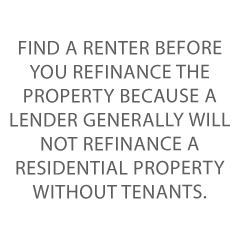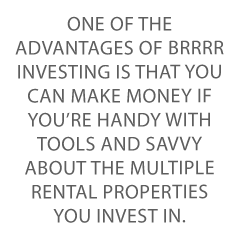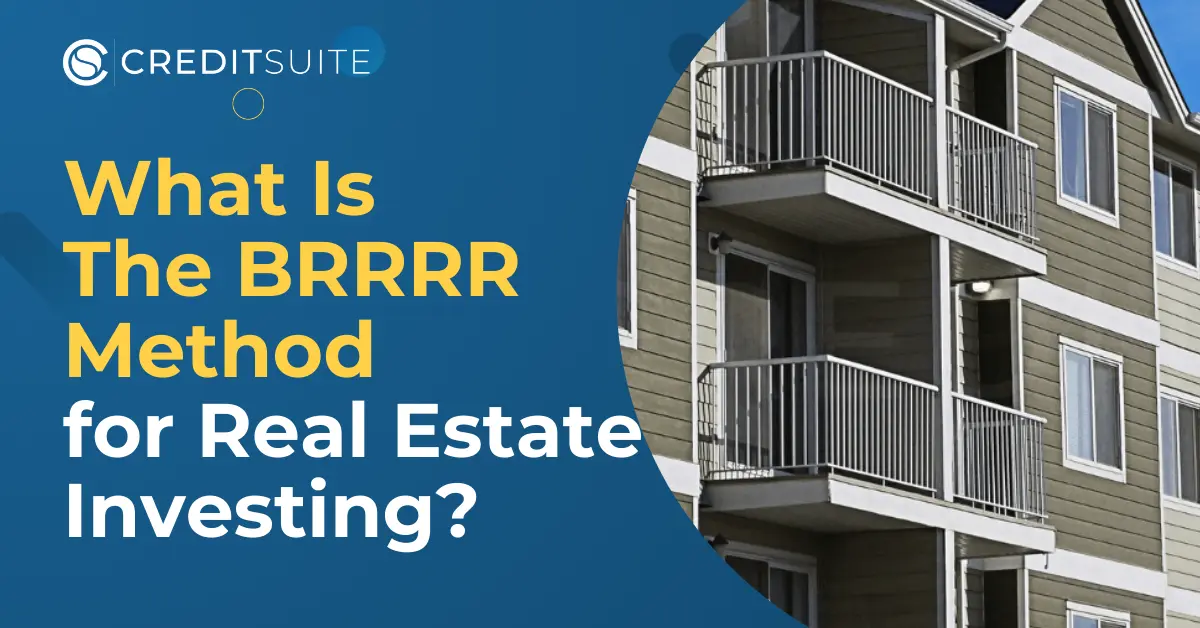If you have ever wanted to try your hand at rehabbing a rundown property and reselling it for a profit, you may have heard of something called the BRRRR Method. Is it the best way to turn a profit from a commercial property?
Let’s look into how BRRR works, when it’s a good idea—and when it isn’t.
What is the BRRRR Method?
BRRRR stands for Buy, Rehab, Rent, Refinance, Repeat. BRRRR strategy is a real estate investment approach. It entails flipping a distressed property, renting it out and then getting a cash out refinance on it to fund further rental property investments.
The idea behind cash out is to convert real estate equity into cash.
The idea behind a BRRRR investment is to generate passive income. It puts your property investment strategy on steroids. Your real estate investment strategy becomes almost like a revolving door. It is a fast way to build a real estate portfolio.
Essentially, you are buying a property, fixing it up, renting it out, refinancing it for more than it’s worth, and taking that loan to purchase another property. The rental income you receive along the way can help you to maintain the first rental property.
The BRRRR strategy is somewhat repetitive, but it does help to assure a relatively steady positive cash flow. The BRRRR strategy is a cycle which, in theory, never needs to end.
So long as the appraised value keeps going up, the cycle can continue with ease.A BRRRR Method investor works to raise a property’s sale value above that of its repair value.
How the BRRRR Method works
Step 1 – Buy Real Estate
The real estate you purchase is going to have to be a distressed property. This is because (a) it will cost you less (have a lower market value) and (b) it will likely be in an area where you can repeat later (see Step #5, below).
You’re investing in a property that will require some work on your part. Chances are that you would not be able to get a conventional mortgage on such a property. This is due to the fact that many lenders require an appraisal but value may be tough to assess before any work is done.
When you buy real estate, some lenders may also require the property to meet certain guidelines before you can qualify. A property in need of truly extensive repair work is not likely to meet such guidelines.
Financing for such a rental property can come in the form of a home equity loan or home equity line of credit (HELOC). Another choice could be a hard money loan. But keep in mind that both of these choices have a higher interest rate and come with risks.
For purchase of a BRRRR property, one of the most important numbers you need to consider is the after-repair value (ARV).
ARV is the estimated value of the home after you renovate or rehab the property. To determine ARV, you compare the planned final result of the home to similar homes (comparables) that have recently sold in the area.
Truly comparable properties should be similar in size, number of bedrooms and bathrooms, age, type of build, and condition.
When you are deciding how much to offer on the home, make sure to follow the 70% rule in real estate. Avoid investing more than 70% of the investment property’s ARV. For example, if a home’s ARV is $400,000, you shouldn’t pay more than $280,000 for the home.
Step 2 – Rehab
Since the investment property is distressed, it may need extensive work. In this step, you will renovate the property to make structural, safety and aesthetic improvements, and prepare it for renters.
When you rehab a rental property, the first improvements you will need to make are any that will bring the building up to code and ensure that it is safe to live in. This can entail bringing the place up to code for electrical, plumbing, and maybe also HVAC.
City, county, and state codes will dictate the minimum standards you will need to meet in many of these areas. The law will cover renter safety, and you will have to abide by it.
Next, you will want to identify the types of improvements that will truly increase value in the rental property. These can include updating the kitchen and bathroom or bathrooms.
Other upgrades can include improving the curb appeal and installing energy-efficient windows, appliances, and other features. What can you add that will attract renters to your property and not to someone else’s?
However, before you start any project, make sure you create a realistic budget and timeline for it. Build in extra cash and time into your project budget and timeline, to allow for any eventualities. But try not to let scope creep overrun the project.
Step 3 – Rent
 Determine the rental price and find renters to let the property. Find a renter before you refinance the property because a lender generally will not refinance a residential property without tenants.
Determine the rental price and find renters to let the property. Find a renter before you refinance the property because a lender generally will not refinance a residential property without tenants.
When it comes to choosing a tenant, check for certain qualities:
- A good record of on-time payments
- You want renters with a stable job with steady income
- Your renter should have a good credit report
- No criminal behavior or history of eviction
- Positive references
You can find this information by meeting with your potential tenant. Have them fill out an application, review their credit report, ask for references, and perform a background check. Of course, you will have to make sure you get their consent and follow all housing laws.
When determining the rent, it’s important to be fair to your renter while the amount of rent can produce a positive cash flow for you.
Determine this by subtracting the total expenses to own the home from the total amount of monthly rent you’ll charge.
For example, if you charge $2,000 per month for rent and your mortgage payment is $1,200. Then, barring any other expenses, your cash flow (rental income) is $800 per month.
Look at the rent for comparables to help you find the right/best price.
Step 4 – Refinance
With a cash-out refinance, you convert your equity in the real estate into cash. You can access your equity by taking out a bigger mortgage and borrowing more money than you currently owe. The cash can be used for anything, including purchasing more real estate.
The idea behind such a refinance is to use the passive income from rent so you can buy your next piece of real estate and get to work on its renovation. In this way, you can become the owner of multiple properties.
Qualifying for such lending will likely mean that you will have to meet a certain minimum credit score requirement. You will have to have equity in the real estate and may need to have owned the real estate for a minimum amount of time before you can get a cash-out refinance.
Because of the time requirement, keep in mind that the BRRRR strategy is a long game. And, if you need to repair your personal credit score, take advantage of that time (and the passive income you are receiving) to improve your FICO score.
Like with any kind of a real estate loan, you will need an appraisal, and you will probably have to pay closing costs. In part, the income you are getting from the property will help to cover these charges.
Step 5 – Repeat
BRRRR real estate is an investment which is designed to repeat itself.
Here, in the last step, you will start the process all over again. Using the cash from your cash-out refinance, buy another property and start its renovation, before renting it out and refinancing that property.
While they complete the steps again, the most successful BRRRR investors will take notes and do what they can to learn from their past mistakes.
One area where you may have made an error at first could be working with a hard money lender. If this was the only funding you could get at first, then so be it. But the second or third time around? Pay off every credit card as soon as you can, and you’ll have more options.
Another may have been not using your excess cash for a traditional method of investing, as opposed to just putting it into a low-yield savings account. When it comes to investing, you don’t just have to be a real estate investor!
Another area to learn from is your overall approach to property management. Were you only doing the minimum? Or were you taking your rental income and using that income to continually add market value to your investment?
In short, are you a good property manager who does more than collect rent income from your tenants?
BRRRR Method Example
Real estate financing like BRRRR may be better explained with an example.
Let’s say you start with a one-family home worth $100,000. And instead of a bridge loan, you go with private money from family and friends.
A full cash offer is a great way to get started as you are not dealing with the bank and its likely requirements for an appraisal and maybe an inspection. You can go right into BRRRR without delay.
Also, you won’t be under the gun to quickly pay the bank—because often funding you get for BRRRR is short term (sometimes as short as six months!). A full cash offer bypasses that.
The seller may very well prefer a cash offer as well. It’s faster for them and, if they are looking to pay down their own debt, they can get on that right away. Your cash on the barrelhead could represent financial freedom for them.
A best practice, certainly for the first time you’re doing this, is bringing a trusted contractor with you. They may be able to find issues that you may miss. Cracks in the foundation, for example, are a large project to tackle. If that’s okay with you, at least you know.
But let’s say that there are no hidden surprises to trip you up.
Now, you’ve got the property. It’s time to budget your cash and your time. Take into account as much as you can. Buffer in extra time and money for eventualities—particularly flood insurance if the property is in a known flood/hurricane/tornado area.
Let’s say your repairs and improvements cost $20,000.
Check local listings to see what a property like yours goes for on the rental market. Will it pay to convert an area into an extra bedroom? Should you change a half-bath to a full? Will you get your investment back in rental income?
Find tenants by advertising the property, and vet them thoroughly. That means a credit check and a request for references. You want to see a recent paycheck, too.
Your next stop is an appraisal, in preparation for refinancing. A new bathroom or deck, or a modernized kitchen, might pay off several times versus what you put into it. Your $20,000 worth of improvements could represent an increase of $45,000 in property value!
Now the property is worth $145,000. But the refinance loan will be for a percentage of loan-to-value. If it’s 75%, then that is $108,750—more than enough to cover the initial purchase price of the building.
Once your refinance loan is in hand, pay off any earlier funding, if any. You may want to pay back your friends and family, or buy them out if you promised them a percentage of your business.
If you’ve got that extra $8,750 once everyone/everything is paid off, it’s your choice whether to move onto buying another property or paying off any financing or putting money into even more renovation and raising the rent.
The last step, of course, is lather, rinse, repeat.
Pros
 One of the advantages of BRRRR investing is that you can make money if you’re handy with tools and savvy about the multiple rental properties you invest in.
One of the advantages of BRRRR investing is that you can make money if you’re handy with tools and savvy about the multiple rental properties you invest in.
And, if you are not, you will become both, if you wish to succeed. Understanding the real estate trends in the area is valuable, and knowing how to negotiate is priceless.
Learning how to make basic repairs that don’t require a license (that is, probably not overhauling an entire electrical system unless you are actually trained and licensed to do so) will help you for years to come.
And that knowledge doesn’t have to be confined to just working on properties you’re investing in. There’s no reason why you, the investor, can’t take that knowhow and apply it to helping your children with their first homes.
You build equity during the rental part of the process. And, as time goes on, you should be able to improve personal credit if necessary, and gain valuable experience.
As you refinance more and more real estate, your ability to get a better BRRRR loan will increase. Better funding means putting down less, and it means lower interest rates. It can mean longer terms as well.
Also, more than one successful refinance with the same lending institution can improve your relationship with the lender. And then when you need any other sort of financing, it will be easier to qualify. Developing a good relationship with a lender is a good investment of your time.
You can become an investor in a neighborhood that’s on the cusp of revitalization, and provide good shelter and amenities for people who truly need it. If you end up employing some of those people, then you’re making an investment in their futures.
Cons
An investor who does not work to improve their real estate can end up as little more than a slumlord. You can end up investing in the downfall of a community if you’re careless.
Some more cons to consider here are the cost and work required for rehabilitating any building. And, since you may not be able to get a traditional mortgage on the building, you may have to get a more expensive or riskier lending product.
Not to mention, what happens if, when you go to refinance, you qualify for less money than you originally planned? BRRRR really only works properly if the value of the realty is continually going up.
On top of that, this method is going to require a depth of patience. Along with waiting until renovation is complete, you may also be required to wait more time than you originally planned before you can get a cash-out refinance.
It may take time to find acceptable renters for the building, too.
Plus, at least when you first get started, you really will have to be comfortable with power tools, painting, plastering, and all the detail work necessary to upgrade your building. If not, then you are hiring contractors.
Acting as the general contractor (assuming you don’t hire one as well) can mean a lot of coordination—and headaches! Not to mention how much all this would cost. Every bit of it will eat into your profits—so you would do well to learn how to hang wallpaper.
BRRRR Method Alternatives
Flipping Houses
Flipping is closely related to BRRRR. But in this case, your real estate investing is in a building only long enough to sell it for a profit. This can involve real estate investing in a building you have to rehab, but not always.
It’s faster than BRRRR, which also means that you need to do all the repair work a lot more quickly in order to realize a profit. If you are closer to retirement than to the start of your working life, flipping could be a better option for you.
One pitfall with flipping is that it works best in an area where there’s a hot real estate market. But once the market cools down, you could find yourself with a white elephant property that you just can’t get rid of.
Sandwich Lease Options
A sandwich lease (also known as a sublet) involves leasing a property from the owner and then, in turn, leasing that same property to another, third party. Sublets are particularly popular in areas with a major difference in tenancy once the summer arrives.
That is, parts of the country where long-term summer leases are desired by tourists, or where there is an abundance of college students, who’ll be away for the summer but want their apartments to still be available when they get back.
Subleasing is not always allowed by the original owner, so the sublessor will need to check their lease carefully before going ahead. The sublessor may also find they’re on the hook for any damages caused by the sublessee (the person they are leasing to).
T0 Down Rentals (That Don’t Need to Be Fixed Up)
This strategy is more traditional. And it is useful if you don’t want your real estate deal to come bundled with a lot of rough carpentry.
Real estate investing in a good neighborhood that is already a destination for people with discretionary income also means you can charge higher rents.
Another advantage is that you are a lot more likely to qualify for a regular loan, as such a property is going to pass any inspection or appraisal with flying colors.
Another plus is that it will take less time to turn a profit with this method.
But one big negative is that you are going to be investing more money to purchase the property.
Takeaways
BRRRR isn’t for everyone.
For one thing, it takes a while. Investors with time on their hands and home improvement skills tend to do the best. If you put the time and effort into learning basics like rough carpentry, hanging wallpaper, and basic plumbing, it will be easier to recoup your real estate investment.
For the initial financing, why not contact us today? We can help you get the ball rolling.

